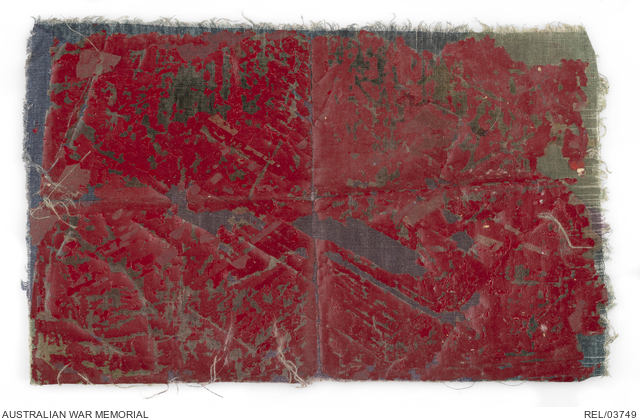| Place | Europe: France, Picardie, Somme, Corbie Albert Area, Corbie |
|---|---|
| Accession Number | REL/03749 |
| Collection type | Heraldry |
| Object type | Heraldry |
| Physical description | Ink, Linen |
| Maker |
Unknown |
| Place made | Germany |
| Date made | c. 1916-1918 |
| Conflict |
First World War, 1914-1918 |
| Source credit to | This item has been digitised with funding provided by Commonwealth Government. |
Aircraft night lozenge camouflage fabric




Fragment of linen cut from a German aircraft. One side of the piece is covered with red paint. This paint covering has cracked and is suffering many losses, but extends to the edges of the fragment. It is clear that the piece was cut from a larger piece of red-painted linen. Munsell approximation of the red is 5R/3/14. The paint has been applied over an existing dope coat. The underlying linen is factory-dyed in a lozenge pattern, with a dark purple, (approximately Munsell 7.5P/3/2) dark blue, (Munsell 2.5B/3/4) dark green (Munsell 2.5GY/4/2) and possibly a black/blue (Munsell 10B/2.5/2). These colours, and the lozenge pattern, are more obvious on the under surface. Only one lozenge is present in its entirity: this is a regular six sided figure with sides of equal length of approx 120 mm , and measures 290 mm across from point to point, and 150 mm across its width. Thread count: 22 threads/cm x 22 threads/cm, 1:1 plain weave.
This is a fragment of German 'night lozenge', almost certainly taken originally from a German night bomber.
Towards the end of the First World war, German aircraft were increasingly making use of pre-printed camouflage 'lozenge' fabric to cover their wings and fuselages. This fabric made use of 6 sided, irregular 'lozenges' (a modern term) in a variety of four and five coloured fabrics. Some were specifically designed for operations over sea; others for operations over the fields of France. This example would have been applied to a long range, multi-engined bomber, possibly one undertaking raids on the British homeland.
The source of the red paint has not been explained: it is possible that it was cut from an area which had insignia or artwork, or it could have been a contemporary attempt to capitalise on the fame of Baron Manfred Von Richthofen, whose Fokker Triplane was painted red, by presenting a fragment of aircraft linen as coming from his aircraft. It is clear that within a very short period of time after the death of Richthofen, those who had genuine samples felt it necessary to certify their samples as originals. The donor of this example gave it to the Australian War Memorial thinking that it was from the Red Baron's aircraft.